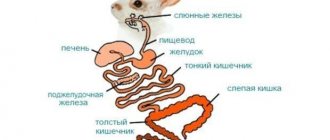The dachshund is a hunting dog breed that first appeared in the 14th century in Germany.
Over such a long period of existence, most breeds lose any skills as unnecessary.
But dachshunds have retained all the features that were originally put into them - intelligence, activity, courage, which are inherent in real hunters.
Dachshunds are also extremely independent.
When should you start training?
You need to start raising and training your dachshund as early as possible. They say about dachshunds that if you miss the moment and do not educate the dog, the dog will educate its owner.
Dog trainers advise starting training of puppies of this breed almost from birth. Dachshunds are superior to other breeds in their intelligence, but they are difficult to train, so education and training should become an integral part of keeping a dog - you should not waste precious time and “let the puppy be a child.”
What should a dog be able to do?
An adult representative of the breed should be able to do a lot.
Like other dogs, the dachshund must follow a set of basic commands:
- "To me!" is one of the first orders taught to any dog.
- "Stand!"
- “In place / Place!” - an extremely necessary command if the animal lives in an apartment.
- "Sit!"
- “You can’t / Fu!” — the dog must master these commands before the first walk, especially when living in a city where there is a risk of poisoning.
The toilet is outside. This rule must be strictly observed by the dog - the pet must clearly understand that it is forbidden to shit the house.
Now let's talk in more detail about how to teach your pet basic skills.
Nickname
First of all, you need to accustom the dog to its name . Moreover, each command should begin with the name of the animal. Subsequently, the pronunciation of the dog’s name will become a kind of “Attention!” signal, which the dachshund will focus on.
Accustoming to a nickname usually happens quite quickly. And this is easy to do - you need to call the dog with a treat for the first time, at the same time calling its name. You need to call the dog from all rooms of the house so that it does not associate its name with a certain room.
Collar and leash
Mastering the skill of walking on a leash is slower than learning a dog's name. But this skill is necessary, because during walks this is one of the most effective ways to control your pet.
Leash training should begin at 2 months. At first, the dog will experience discomfort and make attempts to throw off the collar. But gradually she will get used to this state of affairs.
One of the main points in training a dog to use a collar is to make it clear to the dog that the leash is not a toy. If the animal starts to play with it, it is necessary to rein it in with the command “Fu” or “No”.
NOTE!
Under no circumstances should you use force or take away the leash. Don’t forget, the dachshund is a hunting dog and will not give up its prey just like that.
Toilet
Baby dachshunds up to 6 weeks of age relieve themselves at home using diapers. At 12 weeks of age, litter box training can begin. It will be better if the puppy has a limited space where his bed, bowl and tray are located, then he will quickly understand the “functionality” of these items.
The first time the puppy goes into the litter box, you need to praise him and give him a treat. When the dog “does his business” exclusively in the litter box, you can accustom the puppy to a routine: put his toilet out at a certain time and repeat the command “Walk”. Subsequently (during accustoming to the street) this will play into the owner’s hands.
conclusions
The dog must obey all commands immediately and without hesitation. To do this, you need to regularly conduct classes with her at home, and, if necessary, study useful literature. Thus, before demonstrating the pet’s skills on the street, the owner is obliged to find out as much information as possible about how to train a dachshund at home.
Many owners wonder how to teach a dachshund commands without giving it a treat? The dog must understand when it performs tasks correctly and when it does not. In this case, the treat serves as a kind of confirmation of the correctness of her actions.
Thus, training a dachshund is a very responsible activity. A mandatory requirement for the owner is restraint and tolerance towards his pet. There is no need to take your anger out on him if he doesn’t do something. As a rule, it is not the animals that are to blame for this, but the wrong human approach to them.
Behavior on the street
Walking for dachshunds is only available from the moment all vaccinations . To avoid a stressful situation, for the first walk it is better to choose a secluded place where the risk of meeting another four-legged animal is reduced to zero.
IMPORTANT!
During the first walk, the dog is always nervous and afraid. It is not uncommon for a dog to sit down, start whining, or ask to be held. The owner’s task is to calm the dog down with affection and instill a love for walks.
What sports are played with dachshunds?
Dachshunds are hardy dogs, and their small size and ability to run quickly help the four-legged dog to easily cover huge distances. Therefore, they engage in various sports with their pet, which include:
- assistance while cycling;
- classes in the pool. Water sports help keep your pet's muscles and joints healthy;
- If your child likes to chase other animals, coursing is suitable for him. This is a kind of sports game where the dog must track down the animal;
- Flyball. This is a team sport where four dogs take turns running a hurdle course, at the end they grab a ball and run back;
- Various competitive sports are also suitable.
How to stop chewing things?
A well-honed command “No” or “Fu”, pronounced in a confident tone, stops any attempts by the dog to chew on everything.
If the command has no effect, you can grab the dog by the skin at the withers and shake it. Of course, this method can only be used in extreme cases , when the dog does not respond at all to the owner’s commands.
How to teach basic commands?
As mentioned above, dachshunds are difficult to train and teach commands, because, despite their excellent intelligence and consciousness, representatives of this breed are willful and very active. Training for one command can last from two to five days.
“Give me your paw.”
Basically, the owner pronounces this order during the procedure for cutting the dog’s nails.
The first time, along with pronouncing the command, you need to take the dog by the paw and shake it slightly so that the pet understands the connection between the word and the action. You can also give your dog a treat after performing the command for the first time on your own.
"Show your teeth"
Dogs taking part in exhibitions should already know this command from the age of 4 months. For training, the owner, pronouncing the action, opens the dog’s mouth, holding the jaws with his hands.
NOTE!
This command will also help with hygiene procedures.
"Place".
Most breeders are faced with dog disobedience in the home. And it’s not surprising, because the dachshund is an extremely active dog that finds it very difficult to sit still. However, mastering this command is necessary.
To quickly accustom a puppy to his place, you need to pick him up and, repeating “Place,” take him to the bedding.
Breeders, sharing their experience, indicate that the dachshund feels better in dog baskets or boxes with a blanket (plaid). And this is not surprising - the hunting instincts are felt and the dog feels safe if he builds a kind of hole out of a blanket.
"Sit"
One of the most difficult commands to learn, because... requires dachshunds to be static.
When pronouncing the word, you need to press on the dog’s tailbone until he sits down. Training this team usually doesn't take much time. The main thing is not to forget to give the dog a treat after completing it.
"Stand".
Teaching this command is easier using a leash. When pronouncing the command, you need to pull the leash not too much, but sharply.
Considering the hyperactivity of dachshunds, this command is given with great difficulty, so the owner needs to be patient.
Character traits
The dachshund was bred as a hunting breed. Despite their small size, these dogs protect their owner from any threat. They are fearless, courageous and courageous. The breed is not intended for protection; its restless nature does not allow it to remain in one place. It is believed that the intelligence of a puppy is equal to that of a five-year-old child. Watching and playing with a dog never gets boring.
The average weight of a regular dachshund is 8–16 kg, and a miniature one is 5 kg. Life expectancy is 15 years. An elongated body and short legs are the main difference between the breed. The dogs are active and have good control over their body. In a minute, the dachshund digs a hole 50 cm deep. And its fur does not cause allergies in people.
The character is peaceful, but difficult to train. Dogs understand commands, but sometimes refuse to follow them. This is due to his proud character. They love their owner, and at times they are very jealous, but they cannot follow commands unquestioningly. To train, you need to be patient and treat your pet with affection and respect.
Training by month
1 month – accustoming to a nickname. The dog must know its name. How to train a dog to respond is described above.
2 months – “You can’t”, “To me”, “Place”. Because Few breeders take walks at this age (due to lack of vaccinations), these commands are quite enough to control the puppy indoors. However, it is necessary to begin accustoming your baby to a leash and collar at this age.
3 months – “Stand”, “Sit”, “Give me your paw”, “Show your teeth”. The dog should also know that the toilet is only outside.
At 4 months, the dog must unconditionally come to the owner upon request; eat only what the owner gave; When walking, the dog should calmly walk next to the person, without tugging on the leash.
At 5-6 months, the puppy begins a “transitional age”, when he begins to test the boundaries of what is permitted and often does not follow commands. During this period, the owner needs to gather all his patience and continue training in the same mode as before. In no case should you resort to physical punishment for disobedience, because This will forever undermine the puppy's trust in the person.
How to train a dog to be alone?
For any dog at a young age, the departure of its owner is a horror and a nightmare. Dachshunds are no exception.
They become very attached to “their person” and by the age of 6-7 months they can no longer imagine their existence without him, so every even short separation causes a storm of negative emotions in the dog. Howling, barking and chewed slippers are the least that a dachshund owner will see upon returning home if the dog is not taught to cope with separation.
In order for the dog to react correctly to the owner leaving the apartment/house, you need to follow some rules to teach it to remain alone:
- Before leaving and upon returning, you should not express emotions strongly. If you say goodbye to a dog for a long time, he will take it as a signal that his owner is abandoning him. But you can’t hide your absence either. The dog must get used to the sight of its owner leaving. When you return, you should not hug the dog. You can calmly pet her and go about your business as if nothing had happened.
- The dog should be taught that the owner will return. To do this, you can practice grooming: over the course of several days, get ready, get dressed, wave to the dog, go out the door and come back literally in a minute. This way the dog will understand that the person will definitely return.
- Train your dog to respond to a person leaving. To do this, you can get dressed for several days, say goodbye and not leave anywhere.
- A very important role in accustoming a dog to the care of its owner is played by the “shelter” - the “norm” that the dog will build in its place. There she can hide and calmly wait for her owner, feeling safe.
IMPORTANT!
Do not forget that the howling and barking that a dog makes when the owner is absent can be caused by third-party stimuli - sounds under the door, outside the window, or other animals. Therefore, you should not scold your dog for the sounds it makes.
Mini-dachshund puppies: characteristics and approach to the dog
Among the already miniature representatives of the breed, there is a special variety - dwarf dachshunds. They are also called mini dachshunds. Despite their outward innocence, representatives of this species are no less stubborn than ordinary dachshunds, and therefore also require training.
The differences between mini-dachshund subtypes are striking
Owners who do not like excessive noise, as well as those who have children, are inclined to buy dwarf dachshunds. Mini-dachshunds are more balanced and calm. There are two subtypes of the breed:
Longhair
These dogs have long, wavy hair on their paws and ears, but the coat is not as shiny as other members of the breed. A parting is formed along the croup, and in some places the coat can be very short. They can be of different colors:
- with one color: fawn, yellow, reddish;
- with two colors: brown and tan, black and red;
- maur: dark stripes of fur are randomly located throughout the body.
The peculiarity of the breed is that long hair does not appear immediately. She grows only at one year of age. Long hair requires careful grooming, regular brushing and trimming.
The interdigital area on a dog’s paw requires special care: it needs to be trimmed at least once a month. The same procedure should be carried out in the groin area and on the ears so that the hair on these areas of the body does not roll off.
Longhaired dwarf dachshund puppy
Basic mistakes when training
Mistakes in training dachshunds are made by almost all people who come into contact with a dog of this breed for the first time.
The first mistake is the late start of education. Japanese writer M. Ibuko wrote a book about raising children called “After 3 It’s Too Late.” The same can be said about dachshunds: after 3 months, raising and training a dog is an extremely difficult task.
The second terrible mistake of a dachshund breeder (or any other breed) is physical punishment. You can spank the puppy with a thin newspaper in cases of disobedience, but nothing more, because if force is used, the puppy can grow up intimidated.
Training any dog is a monotonous task. Sometimes it seems that daily activities do not bring any results. But this is far from true. By putting your soul into activities with your pet, a person receives a faithful, loving friend, and not just a trained animal.
With dachshunds everything is somewhat more complicated, because... For such active dogs, mastering the commands “Stay” and “Sit” can be overwhelming. But the breeder should not give up, because... the effort will pay off.











